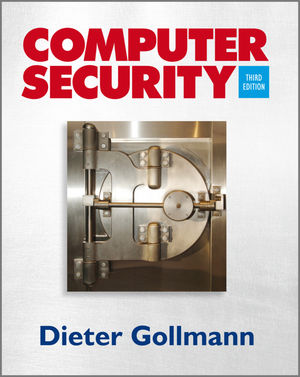|
Textbook
Computer Security, 3rd EditionISBN: 978-0-470-74115-3
Paperback
464 pages
February 2011, ©2011
 This is a Print-on-Demand title. It will be printed specifically to fill your order. Please allow an additional 10-15 days delivery time. The book is not returnable.
|
||||||
CHAPTER 1 – History of Computer Security 1
1.1 The Dawn of Computer Security 2
1.2 1970s – Mainframes 3
1.3 1980s – Personal Computers 4
1.4 1990s – Internet 6
1.5 2000s – The Web 8
1.6 Conclusions – The Benefits of Hindsight 10
1.7 Exercises 11
CHAPTER 2 – Managing Security 13
2.1 Attacks and Attackers 14
2.2 Security Management 15
2.3 Risk and Threat Analysis 21
2.4 Further Reading 29
2.5 Exercises 29
CHAPTER 3 – Foundations of Computer Security 31
3.1 Definitions 32
3.2 The Fundamental Dilemma of Computer Security 40
3.3 Data vs Information 40
3.4 Principles of Computer Security 41
3.5 The Layer Below 45
3.6 The Layer Above 47
3.7 Further Reading 47
3.8 Exercises 48
CHAPTER 4 – Identification and Authentication 49
4.1 Username and Password 50
4.2 Bootstrapping Password Protection 51
4.3 Guessing Passwords 52
4.4 Phishing, Spoofing, and Social Engineering 54
4.5 Protecting the Password File 56
4.6 Single Sign-on 58
4.7 Alternative Approaches 59
4.8 Further Reading 63
4.9 Exercises 63
CHAPTER 5 – Access Control 65
5.1 Background 66
5.2 Authentication and Authorization 66
5.3 Access Operations 68
5.4 Access Control Structures 71
5.5 Ownership 73
5.6 Intermediate Controls 74
5.7 Policy Instantiation 79
5.8 Comparing Security Attributes 79
5.9 Further Reading 84
5.10 Exercises 84
CHAPTER 6 – Reference Monitors 87
6.1 Introduction 88
6.2 Operating System Integrity 90
6.3 Hardware Security Features 91
6.4 Protecting Memory 99
6.5 Further Reading 103
6.6 Exercises 104
CHAPTER 7 – Unix Security 107
7.1 Introduction 108
7.2 Principals 109
7.3 Subjects 111
7.4 Objects 113
7.5 Access Control 116
7.6 Instances of General Security Principles 119
7.7 Management Issues 125
7.8 Further Reading 128
7.9 Exercises 128
CHAPTER 8 – Windows Security 131
8.1 Introduction 132
8.2 Components of Access Control 135
8.3 Access Decisions 142
8.4 Managing Policies 145
8.5 Task-Dependent Access Rights 147
8.6 Administration 150
8.7 Further Reading 153
8.8 Exercises 153
CHAPTER 9 – Database Security 155
9.1 Introduction 156
9.2 Relational Databases 158
9.3 Access Control 162
9.4 Statistical Database Security 167
9.5 Integration with the Operating System 172
9.6 Privacy 173
9.7 Further Reading 175
9.8 Exercises 175
CHAPTER 10 – Software Security 177
10.1 Introduction 178
10.2 Characters and Numbers 179
10.3 Canonical Representations 183
10.4 Memory Management 184
10.5 Data and Code 191
10.6 Race Conditions 193
10.7 Defences 194
10.8 Further Reading 201
10.9 Exercises 202
CHAPTER 11 – Bell–LaPadula Model 205
11.1 State Machine Models 206
11.2 The Bell–LaPadula Model 206
11.3 The Multics Interpretation of BLP 212
11.4 Further Reading 216
11.5 Exercises 216
CHAPTER 12 – Security Models 219
12.1 The Biba Model 220
12.2 Chinese Wall Model 221
12.3 The Clark–Wilson Model 223
12.4 The Harrison–Ruzzo–Ullman Model 225
12.5 Information-Flow Models 228
12.6 Execution Monitors 230
12.7 Further Reading 232
12.8 Exercises 233
CHAPTER 13 – Security Evaluation 235
13.1 Introduction 236
13.2 The Orange Book 239
13.3 The Rainbow Series 241
13.4 Information Technology Security Evaluation Criteria 242
13.5 The Federal Criteria 243
13.6 The Common Criteria 243
13.7 Quality Standards 246
13.8 An Effort Well Spent? 247
13.9 Summary 248
13.10 Further Reading 248
13.11 Exercises 249
CHAPTER 14 – Cryptography 251
14.1 Introduction 252
14.2 Modular Arithmetic 256
14.3 Integrity Check Functions 257
14.4 Digital Signatures 260
14.5 Encryption 264
14.6 Strength of Mechanisms 270
14.7 Performance 271
14.8 Further Reading 272
14.9 Exercises 273
CHAPTER 15 – Key Establishment 275
15.1 Introduction 276
15.2 Key Establishment and Authentication 276
15.3 Key Establishment Protocols 279
15.4 Kerberos 283
15.5 Public-Key Infrastructures 288
15.6 Trusted Computing – Attestation 293
15.7 Further Reading 295
15.8 Exercises 295
CHAPTER 16 – Communications Security 297
16.1 Introduction 298
16.2 Protocol Design Principles 299
16.3 IP Security 301
16.4 IPsec and Network Address Translation 308
16.5 SSL/TLS 310
16.6 Extensible Authentication Protocol 314
16.7 Further Reading 316
16.8 Exercises 316
CHAPTER 17 – Network Security 319
17.1 Introduction 320
17.2 Domain Name System 322
17.3 Firewalls 328
17.4 Intrusion Detection 332
17.5 Further Reading 335
17.6 Exercises 336
CHAPTER 18 – Web Security 339
18.1 Introduction 340
18.2 Authenticated Sessions 342
18.3 Code Origin Policies 346
18.4 Cross-Site Scripting 347
18.5 Cross-Site Request Forgery 350
18.6 JavaScript Hijacking 352
18.7 Web Services Security 354
18.8 Further Reading 360
18.9 Exercises 361
CHAPTER 19 – Mobility 363
19.1 Introduction 364
19.2 GSM 364
19.3 UMTS 369
19.4 Mobile IPv6 Security 372
19.5 WLAN 377
19.6 Bluetooth 381
19.7 Further Reading 383
19.8 Exercises 383
CHAPTER 20 – New Access Control Paradigms 385
20.1 Introduction 386
20.2 SPKI 388
20.3 Trust Management 390
20.4 Code-Based Access Control 391
20.5 Java Security 395
20.6 .NET Security Framework 400
20.7 Digital Rights Management 405
20.8 Further Reading 406
20.9 Exercises 406
Bibliography 409
Index 423



